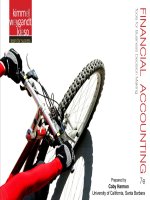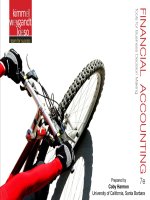Financial accounting 8e tool for busniess decision making chapter 13
Bạn đang xem bản rút gọn của tài liệu. Xem và tải ngay bản đầy đủ của tài liệu tại đây (3.39 MB, 72 trang )
13-1
13
Financial Analysis: The Big
Picture
Kimmel ● Weygandt ● Kieso
Financial Accounting, Eighth Edition
13-2
CHAPTER OUTLINE
LEARNING OBJECTIVES
13-3
1
Apply the concepts of sustainable income and
quality of earnings.
2
Apply horizontal analysis and vertical
analysis.
3
Analyze a company’s performance using ratio
analysis.
LEARNING
OBJECTIVE
1
Apply the concepts of sustainable
income and quality of earnings.
SUSTAINABLE INCOME
The most likely level of income to be obtained by a company
in the future.
Unusual Items
Separately identified on the income statement.
Discontinued
Other
operations.
comprehensive income.
These “irregular” items are reported net of income tax.
13-4
LO 1
SUSTAINABLE INCOME
13-5
ILLUSTRATION 13-1
Statement of comprehensive
income
LO 1
SUSTAINABLE INCOME
Discontinued Operations
(a)Disposal of a significant component of a business.
(b)Income statement should report a gain (or loss) from
discontinued operations, net of tax.
13-6
LO 1
Discontinued Operations
Illustration: Assume that during 2017 Acro Energy Inc. has
income before income taxes of $800,000. During 2017, Acro
discontinued and sold its unprofitable chemical division. The
loss in 2017 from chemical operations (net of $60,000 taxes)
was $140,000. The loss on disposal of the chemical division
(net of $30,000 taxes) was $70,000. Assuming a 30% tax rate
on income.
Prepare Acro’s statement of comprehensive income for the year
ended December 31, 2017.
13-7
LO 1
Discontinued Operations
ILLUSTRATION 13-2
Statement presentation of discontinued operations
13-8
LO 1
INVESTOR INSIGHT
What Does “Non-Recurring” Really Mean
Many companies incur restructuring charges as they attempt to reduce
costs. They often label these items in the income statement as “nonrecurring” charges, to suggest that they are isolated events, unlikely to
occur in future periods. The question for analysts is, are these costs
really one-time, “nonrecurring events” or do they reflect problems that
the company will be facing for many periods in the future? If they are
one-time events, then they can be largely ignored when trying to
predict future earnings. But, some companies report “one-time”
restructuring charges over and over again. For example, Procter &
Gamble reported a restructuring charge in 12 consecutive quarters,
and Motorola had “special” charges in 14 consecutive quarters. On the
other hand, other companies have a restructuring charge only once in
a 5- or 10-year period. There appears to be no substitute for careful
analysis of the numbers that comprise net income.
13-9
LO 1
SUSTAINABLE INCOME
Comprehensive Income
All changes in stockholders’ equity except those resulting
from
investments
by stockholders and
distributions
to stockholders.
Certain gains and losses bypass net income and instead
are reported as direct adjustments to stockholders’ equity.
Example
– Unrealized gain or loss on Available-forsale securities.
13-10
LO 1
Comprehensive Income
ILLUSTRATION OF COMPREHENSIVE INCOME
Accounting standards require companies to adjust most
investments in stocks and bonds up or down to their market
value at the end of each accounting period.
Illustration: During 2017 Stassi Company purchased IBM stock
for $10,000 as an investment. At the end of 2017 Stassi was still
holding the investment, but the stock’s market value was now
$8,000.
How should Stassi account for the $2,000 unrealized loss?
13-11
LO 1
Comprehensive Income
ILLUSTRATION OF COMPREHENSIVE INCOME
How should Stassi account for the $2,000 unrealized loss?
Answer: Depends on whether Stassi classifies the IBM stock
as a
Trading
security or an
Available
for-sale security.
Unrealized gains
and losses
(Income Statement)
Unrealized gains and losses
(Comprehensive Income - Stockholders’ Equity)
13-12
LO 1
Comprehensive Income
Format One
Combined statement of income and comprehensive income.
Illustration 13-5
ILLUSTRATION 13-3
Lower portion of combined statement of
income and comprehensive income
13-13
LO 1
Comprehensive Income
Format Two
Separate component of Stockholders’ Equity.
ILLUSTRATION 13-4
Unrealized loss in stockholders’ equity section
13-14
LO 1
ILLUSTRATION 13-5
Complete statement of
comprehensive income
13-15
SUSTAINABLE INCOME
Changes in Accounting Principle
Principle
used in the current year is different from one
used in the preceding year.
Example
- change from FIFO to average cost.
Permissible
when management can show new principle is
preferable.
Most
13-16
changes are reported retroactively.
LO 1
INVESTOR INSIGHT
United Parcel Service (UPS)
More Frequent Ups and Downs
In the past, U.S. companies used a method to account for their pension
plans that smoothed out the gains and losses on their pension portfolios by
spreading gains and losses over multiple years. Many felt that this
approach was beneficial because it reduced the volatility of reported net
income. However, recently some companies have opted to adopt a method
that comes closer to recognizing gains and losses in the period in which
they occur. Some of the companies that have adopted this approach are
United Parcel Service (UPS), Honeywell International, IBM, AT&T, and
Verizon Communications. The CFO at UPS said he favored the new
approach because “events that occurred in prior years will no longer distort
current-year results. It will result in better transparency by eliminating the
noise of past plan performance.” When UPS switched, it resulted in a
charge of $827 million from the change in accounting principle.
Source: Bob Sechler and Doug Cameron, “UPS Alters Pension-Plan Accounting,”
Wall Street Journal (January 30, 2012).
13-17
LO 1
QUALITY OF EARNINGS
A company that has a high quality of earnings provides
full and transparent information that will not confuse or
mislead users of the financial statements.
Recent accounting scandals suggest that some
companies are spending too much time managing their
income and not enough time managing their
business.
13-18
LO 1
QUALITY OF EARNINGS
Alternative Accounting Methods
Variations
among companies in the application of GAAP
may hamper comparability and reduce quality of
earnings (FIFO vs. LIFO).
Pro Forma Income
Usually
excludes items that are unusual or nonrecurring.
Some
companies have abused the flexibility that pro
forma numbers allow to put their companies in a more
favorable light.
13-19
LO 1
QUALITY OF EARNINGS
Improper Recognition
Some managers have felt pressure to continually increase
earnings.
Abuses include:
Improper
recognition of revenue (channel stuffing).
Improper
capitalization of operating expenses
(WorldCom).
Failure
13-20
to report all liabilities (Enron).
LO 1
DO IT!
1
Unusual Items
In its proposed 2017 income statement, AIR Corporation
reports income before income taxes $400,000, unrealized gain
on available-for-sale securities $100,000, income taxes
$120,000 (not including unusual items), loss from operation of
discontinued flower division $50,000, and loss on disposal of
discontinued flower division $90,000. The income tax rate is
30%.
Prepare a correct statement of comprehensive income,
beginning with “Income before income taxes.”
13-21
LO 1
DO IT!
13-22
1
Unusual Items
LO 1
LEARNING
OBJECTIVE
2
Apply horizontal analysis and vertical
analysis.
Analyzing financial statements involves:
Comparison
Bases
13-23
Basic Tools
Intracompany
Horizontal analysis
Intercompany
Vertical analysis
Industry averages
Ratio Analysis
LO 2
HORIZONTAL ANALYSIS
Also called trend analysis, is a technique for evaluating a
series of financial statement data over a period of time.
Purpose
is to determine increase or decrease that has
taken place.
Commonly
applied to the balance sheet and income
statement.
13-24
LO 2
ILLUSTRATION 13-9
Horizontal analysis of
balance sheets
13-25









